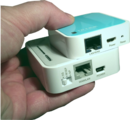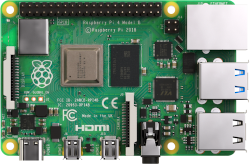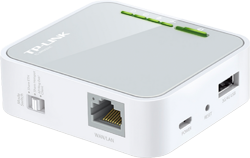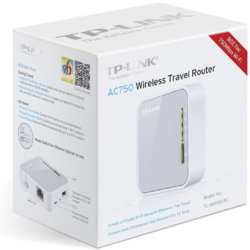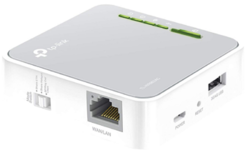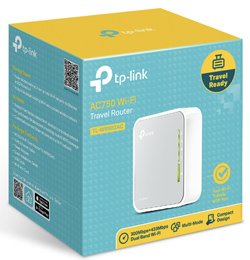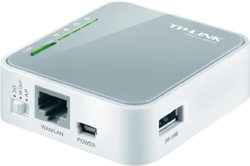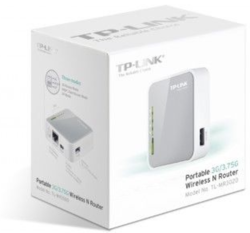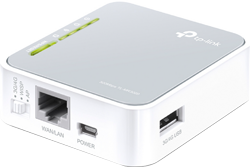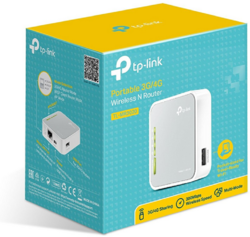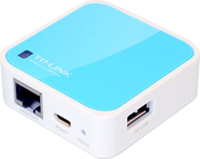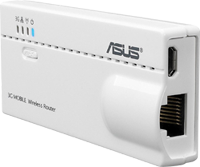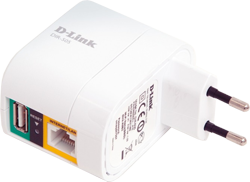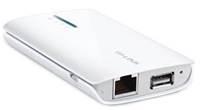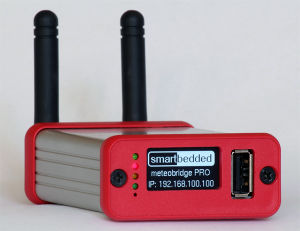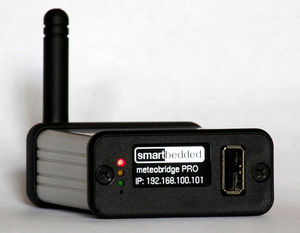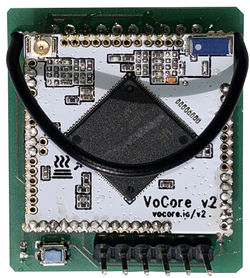Hardware
Contents
- 1 Compatibility Overview
- 2 Raspberry Pi Model 3B, 3B+, 4B
- 3 TP-LINK TL-WR902AC (version 1.x)
- 4 TP-LINK TL-WR902AC (version 3.x)
- 5 TP-LINK TL-MR3020 (version 1.x)
- 6 TP-LINK TL-MR3020v3 (version 3.x)
- 7 TP-LINK TL-WR703N (versions up to 1.6 only)
- 8 ASUS WL-330N3G
- 9 D-Link DIR-505
- 10 TP-LINK TL-MR3040 (version 2.x)
- 11 Meteobridge PRO
- 12 Meteobridge NANO
Meteobridge can be used with a variety of miniature consumer routers from TP-LINK, one from D-Link and one from ASUS, or you can by a Meteobridge PRO which comes on dedicated hardware. The devices from TP-Lin, D-Link and Asus are converted into a Meteobridge by flashing a new firmware. As always when you flash un-official firmware to a device you are voiding the manufacturers warranty. That means, when the device gets faulty later on, you can't reach out to TP-LINK, D-Link or ASUS for warranty. smartbedded UG, which owns the Meteobridge software, does also not provide any warranty on flashed device. As the routers are very cheap and risk of bricking the device is minimal, you don't have a significant financial exposure. However, you have to know, that you are converting the router into a Meteobridge at your own risk. If you don't want to take the risk, please buy a ready-made Meteobridge solution from one of the resellers or you go with a Meteobridge PRO.
Compatibility Overview
Over time new hardware revisions of devices originally supported by Meteobridge did show up. Some of those are no longer capable to be reflashed with a Meteobridge image some are. Table below does gives you an overview of supported devices and hardware versions.
| Manufacturer | Model | HW Version | Remark on Meteobridge Compatibility |
| Raspberry | Pi Model 3B, 3B+, 4B | a disk image needs to be copied to a compatible micro SD card. Only industrial SLC micro SD cards are supported, like with Meteobridge NANO SD. | |
| TP-Link | MR3020 | 1.x | Can be flashed via stock web interface. |
| TP-Link | MR3020 | 3.x | Can only be flashed via TFTP. |
| TP-Link | MR3040 | 1.x | Not supported. |
| TP-Link | MR3040 | 2.x | Can be flashed via stock web interface. |
| TP-Link | MWR902AC | 1.x | Can be flashed via stock web interface. |
| TP-Link | MWR902AC | 3.x | Can only be flashed via TFTP. |
| TP-Link | WR703N | up to 1.6 | Can be flashed via stock web interface (a bit complicated as it is in Chinese language). |
| TP-Link | WR703N | 1.7 and above | Not supported. |
| D-Link | DIR 505 | A1, A2 | Can be flashed via stock web interface. |
| Asus | WL-330N3G | Some models can be flashed via a TFTP client. You cannot see from the outside if the device you have is supported. |
Raspberry Pi Model 3B, 3B+, 4B
Any of the Raspberry Pi models 3B, 3B+ and 4B are supported. As Meteobridge is not high on RAM demand, the smallest RAM version will be fine. Meteobridge disk image is copied onto a Micro SD card with a low level disk copy tool like "etcher". To avoid SD card failure after a couple of months, Meteobridge enforces the use of one of the following industrial SLC cards:- swissbit SFSD1024N1BM1TO-I-DF-2A1-STD (microSD Card, 1 GB, SLC Flash, -40°C - 85°C)
- swissbit SFSD2048N1BM1TO-I-DF-2A1-STD (microSD Card, 2 GB, SLC Flash, -40°C - 85°C)
- swissbit SFSD1024N1BM1TO-I-DF-221-STD (microSD Card, 1 GB, SLC Flash, -40°C - 85°C)
- swissbit SFSD2048N1BM1MT-I-ME-221-STD (microSD Card, 2 GB, SLC Flash, -40°C - 85°C)
- swissbit SFSD2048N1BM1MT-E-ME-221-STD (microSD Card, 2 GB, SLC Flash, -25°C - 85°C)
- ATP AF2GUDI (microSD Card, 2 GB, SLC Flash, -40°C – 80°C)
- Cactus KS2GRIT-803M (microSD Card, 2 GB, SLC Flash, -45°C – 90°C)
- Panasonic SMSC02DA1 (microSD Card, 2 GB, SLC Flash, -40°C - 85°C)
- Apacer MSD02GIDI-T (microSD Card, 2 GB, SLC Flash)
- Western Digital/SanDisk SDSDQED-008G-XI, SDSDQED-016G-XI, SDSDQED-032G-XI, SDSDQED-064G-XI (microSD Card, 8-64 GB, SLC Flash)
- Greenliant GLS93MP008G1-I-BZ801 (microSD Card, 8 GB, SLC Flash)
The Meteobridge disk image automatically adjusts to the full size of the SD card. When money is no issue you can also use versions of the above cards with greater capacity. Going below 1 GB is not recommended. As Meteobridge does come with its own openwrt-based operating system, installing additional SW onto the Meteobridge will not be possible in most cases. The idea of Meteobridge is to convert your Raspberry Pi into an exclusive weather data server. It is not meant as an experimental platform to try out generic Raspberry Pi stuff.
TP-LINK TL-WR902AC (version 1.x)
TL-WR902AC from TP-Link is a tiny WLAN router, which is world-wide available for around $50. Flashing the unit with Meteobridge firmware makes the router a Meteobridge. This router hardware comes with the following features:- 8 MB flash
- 64 MB RAM
- One LAN port
- Internal dual-band WLAN (2.4 GHz and 5 GHz bands are supported, no external antenna)
- USB 2.0 port
- A couple of activity LEDs (USB, LAN, WLAN)
- Illuminated button on the top
- Dimensions: 2.9 x 2.6 x 0.9 inch (74 x 67 x22 mm)
- Weight: 2.0 oz (58 g) without accessories
- Temperature: 0°C ~40°C operating (-40°C~70°C storage)
- Humidity: 10%~90% operating (5%~90% storage)
- Power Consumption: 2 watts
- Certificates: CE, FCC, RoHS
- As a consumer router world-wide available from TP-Link
- Street price around $50
TP-LINK TL-WR902AC (version 3.x)
TL-WR902AC from TP-Link is a tiny WLAN router, which is world-wide available for around $50. Flashing the unit with Meteobridge firmware makes the router a Meteobridge. This router hardware comes with the following features:- 8 MB flash
- 64 MB RAM
- One LAN port
- Internal dual-band WLAN (2.4 GHz and 5 GHz bands are supported, no external antenna)
- USB 2.0 port
- A couple of activity LEDs (USB, LAN, WLAN)
- Illuminated button on the top
- Dimensions: 2.9 x 2.6 x 0.9 inch (74 x 67 x22 mm)
- Weight: 2.0 oz (58 g) without accessories
- Temperature: 0°C ~40°C operating (-40°C~70°C storage)
- Humidity: 10%~90% operating (5%~90% storage)
- Power Consumption: 2 watts
- Certificates: CE, FCC, RoHS
- As a consumer router world-wide available from TP-Link
- Street price around $50
TP-LINK TL-MR3020 (version 1.x)
TL-MR3020 from TP-Link is a tiny WLAN router, which is word-wide available for less than $40. Flashing the unit with Meteobridge firmware makes the router a Meteobridge. This router hardware comes with the following features:- 4 MB flash
- 32 MB RAM
- One LAN port
- Internal WLAN (no external antenna)
- USB 2.0 only port (not capable of driving USB 1.x devices, will need a USB 2.0 Hub inbetween)
- A couple of activity LEDs (USB, LAN, WLAN)
- Illuminated button on the top
- Dimensions: 2.9 x 2.6 x 0.9 inch (74 x 67 x22 mm)
- Weight: 2.0 oz (58 g) without accessories
- Temperature: -10°C ~60°C operating (-40°C~80°C storage)
- Humidity: 10%~90% operating (5%~90% storage)
- Power Consumption: 1-2 watts
- Certificates: CE, FCC, RoHS
- As a consumer router world-wide available from TP-Link
- Street price below $40
TP-LINK TL-MR3020v3 (version 3.x)
TL-MR3020v3 from TP-Link is an updated version of the legacy TL-MR3020 but with completely changed internals. This new platform has twice the RAM and Flash-ROM than the former TL-MR3020 models and does not need a USB hub to connect to USB 1.x devices. This router hardware comes with the following features:- 8 MB flash
- 64 MB RAM
- One LAN port
- Internal WLAN (no external antenna)
- USB 2.0 port
- A couple of activity LEDs (USB, LAN, WLAN)
- Illuminated button on the top
- Dimensions: 2.9 x 2.6 x 0.9 inch (74 x 67 x22 mm)
- Weight: 2.0 oz (58 g) without accessories
- Temperature: -10°C ~60°C operating (-40°C~80°C storage)
- Humidity: 10%~90% operating (5%~90% storage)
- Power Consumption: 1-2 watts
- Certificates: CE, FCC, RoHS
- As a consumer router world-wide available from TP-Link
- Street price below $40
TP-LINK TL-WR703N (versions up to 1.6 only)
TL-WR703N from TP-Link is the little brother of TL-MR3020. While technical specs are nearly identical it comes with an even smaller form factor and less LEDs for signaling status. TP-LINK does sell WR703N just on the China market, but you can easily get one via ebay for less than $30. Router hardware comes with the following features:- 4 MB flash
- 32 MB RAM
- One LAN port
- Internal WLAN (no external antenna)
- USB 2.0 only port (not capable of driving USB 1.x devices, will need a USB 2.0 Hub inbetween)
- One activity LED
- Reset button behind a pinhole at the back
- Dimensions: 2.2 x 2.2 x 0.7 inch (57 x 57 x 18 mm)
- Weight: 1.3 oz (36 g) without accessories
- Temperature: -10°C~60°C operating (-40°C~80°C storage)
- Humidity: 10%~90% operating (5%~90% storage)
- Power Consumption: 1 watts
- Certificates: no indication of CE, FCC, RoHS
- only available for China market from TP-Link, but easy to get world-wide via China-based ebay sellers
- Street price: below $30
ASUS WL-330N3G
WARNING: newest version of this device does not allow to be flashed with Meteobridge firmware. You can't tell from the outside if a specific WL-330N3G router is part of this new, blocking production batch or an older version that can be updated fine. Therefore, it is no longer recommended to buy this hardware, when you want to flash it to become a Meteobridge. We will continue to support successfully flashed "old" versions.
This tiny router from ASUS has similar specs like the ones from TP-Link. Flashing the unit is a bit more complicated (cannot be done via web interface, needs TFTP in a prepared LAN) but it can handle USB 1.x and USB 2.0 devices without need for an additional USB hub. Please do not confuse this router with its predecessor WL-330N, which is not suitable for Meteobridge.- 4 MB flash
- 32 MB RAM
- One LAN port
- Internal WLAN (no external antenna)
- USB 2.0 port (capable of driving USB 1.x and USB 2.0 devices)
- A couple of activity LEDs (Power, USB, LAN, WLAN)
- One button on the top and a non-functional reset button behind a larger pin hole at the bottom
- Dimensions: 90 x 38.9 x 12.8 mm (LxWxH)
- Weight: 1.3 oz (35 g) without accessories
- Power Consumption: abt. 1-2 watts
- Certificates: CE, FCC, RoHS
- As a consumer router world-wide available from ASUS
- Street price: depends on region, cheaper in Europe/Asia (30 Euro), more expansive in the US ($50)
D-Link DIR-505
DIR-505 from D-Link is a tiny WLAN router, which is word-wide available for less than $40. Flashing the unit with Meteobridge firmware makes the router a Meteobridge. Meteobridge firmware is tested with DIR-505 A1 and A2 models. This router hardware comes with the following features:- 8 MB flash
- 64 MB RAM
- One LAN port
- Internal WLAN (no external antenna)
- USB 2.0 only port(not capable of driving USB 1.x devices, will need a USB 2.0 Hub inbetween)
- One activity LEDs
- User accessable utton on one of the sides
- reset button at the USB/LAN connector panel behing a pinhole
- Dimensions: 2.68 x 1.65 x 2 inch (68 x 42 x 51 mm)
- Weight: 3.67 oz (104 g) without accessories
- Temperature: 0°C ~ 40°C operating
- Humidity: 0%~90% operating (non-condesing)
- Power Consumption: 1-2 watts
- Certificates: CE, FCC, RoHS
- As a consumer router world-wide available from D-Link
- Street price below $40
TP-LINK TL-MR3040 (version 2.x)
TL-MR3040 from TP-Link is a tiny WLAN router, which is word-wide available for less than $40. Flashing the unit with Meteobridge firmware makes the router a Meteobridge. Meteobridge firmware is tested with currently sold TL-MR3040 which are version 2.x. This router hardware comes with the following features:- 4 MB flash
- 32 MB RAM
- One LAN port
- Internal WLAN (no external antenna)
- USB 2.0 only port (not capable of driving USB 1.x devices, will need a USB 2.0 Hub inbetween)
- A couple of activity LEDs (USB, LAN, WLAN)
- Reset button behind pin hole near USB port
- Dimensions: 3.9 x 2.4 x 0.6 inch (100 x 62 x 16 mm)
- Weight: 3.3 oz (94 g) without accessories
- Temperature: -10°C ~60°C operating
- Humidity: 10%~90% operating (no condensing)
- internal 2000mAh rechargeable battery
- Power Consumption: 1-2 watts
- Certificates: CE, FCC, RoHS
- As a consumer router world-wide available from TP-Link
- Street price below $40
Meteobridge PRO
Meteobridge PRO is specialized hardware for Meteobridge. You can only buy it fully installed with SW and license and yes, it is more expansive then reflashing one of the miniature plastic routers above. But it also offers much more:- 16 MB flash
- 64 MB RAM
- One LAN port
- Internal WLAN with external RPSMA antenna
- 2 external USB 2.0 ports that can also handle USB 1.x devices
- Internal 1 GB industrial SLC USB storage
- LEDs for RF reception, network traffic, data storage, system status
- 128x64 graphical OLED (black/white)
- Internal sensors for temperature, humidity, pressure, voltage, power
- Power Consumption: 1-2 watts, powered from console
- Reset button behind pin hole on front panel
- Dimensions: 57 x 95 x 27 mm
- Weight: 130 g with antennas, without accessories
- Temperature: -10°C ~ 60°C operating
- Humidity: 10%~90% operating (no condensing)
- Certification: CE, IC, FCC, RoHS
- International power supply
Meteobridge NANO
Meteobridge NANO is specialized hardware for Davis Instruments consoles or Envoy or Envoy 8x. I gets inserted in the expansion slot at the back of the console and operates like any of the other Meteobridges. You can only buy it fully installed with SW and license. When equipped with an optional microSD card it offers local data storage and graphing as the Meteobridge PRO does:- 16 MB flash
- 128 MB RAM
- no LAN port
- Internal WLAN with internal chip antenna
- no USB ports, but beside the console it can connect to other IP weather stations via WLAN.
- optional: supports a defined list industrial SLC microSD cards ranging from 1 - 64 GB
- LEDs for RF reception, network traffic, data storage, system status
- Power Consumption: 1-2 watts
- Reset button on PCB beside 6x pin header
- Dimensions: 35 x 30 x 17 mm
- Weight: 10 g
- Temperature: 10°C ~ 40°C operating
- Humidity: 10%~90% operating (no condensing)
- Certification: CE, IC, FCC, RoHS
